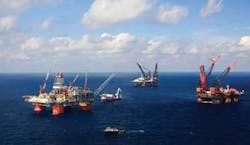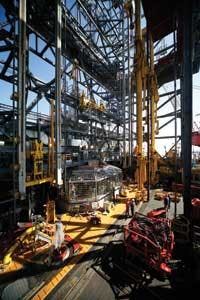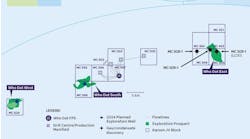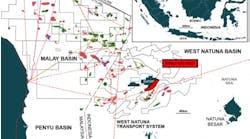Ray Viator - BP
In December 2008, BP successfully started production from the third and fourth wells at the Thunder Horse South field in the US Gulf of Mexico with production in excess of 200,000 boe/d. The company plans to start-up additional production from wells in the Thunder Horse North field this year. BP operates Thunder Horse with 75% ownership. ExxonMobil has 25%.
“Thunder Horse’s current production is a significant new source of US domestic energy, and is the second largest producing oil field in the US,” says Neil Shaw, BP senior vice president for Gulf or Mexico. “Thunder Horse has pushed the frontiers of deepwater technology that will be critical to our next phase of deepwater projects and to supplying America’s energy needs.”
Pictured from left to right is BP’s semisubmersible production platformThunder Horse and Heerema’s semisubmersible construction vessels. Photo credit: 2008 BP Imageshop/Marc Morrison.
Sitting in 6,000 ft (1,829 m) of water about 150 mi (241 km) offshore, theThunder Horse production-drilling-quarters (PDQ) semisubmersible is the largest production semi ever built, with a total displacement of 130,000 tons (117,934 metric tons). The topsides area of Thunder Horseis the size of about three football fields, and is packed with equipment and systems to treat and export 250,000 b/d of oil plus associated gas.
“Thunder Horse has set new levels for deepwater exploration and production,” says Andy Inglis, BP’s chief executive of Exploration and Production. “With scores of new pieces of equipment or processes incorporated into the project, Thunder Horse has driven research and development efforts in many areas, including imaging and reservoir surveillance, drilling and completions equipment, and subsea and topsides production equipment.”
Technology evolution
When Thunder Horse was discovered in 1999, much of the technology necessary to develop the field did not exist. There was a significant prize but getting it out of the ground safely and efficiently would require a major evolution of the technology.
“Explorers have always gone beyond the limits and our engineers have always stepped forward to deliver solutions that seemed impossible at the moment of discovery,” says Shaw.
Every major feature of Thunder Horse – from discovery to production – has required BP and the industry to develop new capabilities, systems, and equipment, and required a combination of applied research and development, discipline, and focus, says Dan Replogle, Thunder Horse vice president. “The challenges of Thunder Horse brought out the best in our people and the best in the industry.”
Pictured here is a rendition of the subsea architecture. A total of 22 production wells and 11 water injectors are planned for both North and South Field development for Thunder Horse. The final complement will depend on reservoir performance. Photo credit: 2008 BP Imageshop/Marc Morrison.
Harnessing Thunder Horse posed challenges in almost every aspect of development, Replogle says. With this level of size and scale, integration was critical to success.
“Everything is interrelated and, as a result, you can’t do anything in isolation. This requires a very well defined and coordinated approach involving every aspect of a project as complex as Thunder Horse. Because of the enormity of the project, you can’t have a small problem. Even small issues can quickly magnify because of the compounding effect.”
The list of challenges began with its location in ultra deep waters with both loop currents and the threat of hurricanes. The project also was forced to contend with reservoir temperatures up to 270º F (132° C), pressures up to 18,000 psi (124 MPa), and the sheer size of the reservoir with flow rates of up to 50,000 b/d of oil/well.
As a result, Thunder Horse required larger bore tubing inside the wells than is normally used in the Gulf of Mexico. Constructed of high-strength materials, the tubing reached up to 7 in. (18 cm) in diameter.
Corralling the subsurface
The Thunder Horse South field features a four-way structural closure while the North field is a three-way structural closure. The development plan targeted three major reservoirs ranging from 18,000 ft to 30,000 ft (5,486 m to 9,144 m) in measured depth. “We knew we had world-class reservoirs but at the time subsalt imaging was relatively new in the industry,” says Greg Arnold, Thunder Horse resource manager.
Project plans also included water injection capability for reservoir pressure support and enhanced recovery.
Real-time monitoring and analysis of production rates is required to keep the processing facility fully loaded and to forecast when water breakthroughs might occur in the reservoir. Each well is monitored in real time.
“Given the rate of production from each well, we recognized early on that even small changes in downhole pressure or temperature could be magnified and have significant impact on our production plans,” says Arnold.
While other GoM fields may be monitored with single gauges, for example, the subsurface team incorporated three gauges plus two independent controls on each of the three gauges for each Thunder Horse well.
“We built redundancies into the system to ensure we would be able to get reliable information throughout the life of the wells,” Arnold says.
Initial results from the first four wells have exceeded start-up expectations for connected volume and energy in the reservoir.
Since oil production began, Arnold says, his team also has begun to focus on identifying unswept pockets of oil.
“The more information we have, the more accurate we can be in targeting those areas and in ensuring that we maximize production throughout the reservoir.”
Drilling in a new environment
The Thunder Horse team has been drilling and completing wells in the area since the original exploration well in 1999. In 6,400 ft (1,951 m) of water, the field’s wells reach to about 29,000 ft (8.839 m) measured depth and 26,000 ft (7,925 m) TVD. The wells team has overcome challenges associated with high-pressure/high-temperature (HP/HT) drilling. Some wells, for example, require up to eight casing strings in order to drill in the narrow pore-pressure-to-fracture gradient window.
Now that production has started, the team is addressing the challenges of drilling through depleted zones.
Thunder Horse required over 100 serial No. 001 items in the first completion, and intelligent wells are being planned for future development.
The completions require a wellbore with large diameter tapered casing strings to accommodate the 7-in. (17.78-cm) tubing and large surface casing/subsurface safety valves. In addition, the different reservoirs require multiple completion techniques including cased and perforated, frac pack and High Rate Water Pack sand control, and multi-zone completions.
Sophisticated metallurgy, such as nickel alloys and 25-chrome, was required in the critical completion components to prevent corrosion associated with hydrogen sulfide contamination from field-water injection.
The rigs used for Thunder Horse are among the most advanced in the industry, says Charles Holt, Thunder Horse wells operations manager.Discoverer Enterprise, a fifth generation drillship, was selected for Thunder Horse because of its capabilities. In addition, the Thunder Horse facility and its twin derricks were designed to address the field’s technical challenges. The rig’s capabilities, such as derrick capacity, mud volumes, and pumping capability, equals or exceeds those of any other rig. Its derrick capability allows multiple activities simultaneously, Holt points out.
Pushing subsea technology
“We’ve focused on learning more about materials and how they operate in this environment with high temperatures and high pressure, as well as how all of those materials interact with one another,” says Karen Veerkamp, Thunder Horse subsea engineering manager.
One of the top technological developments to arise from the Thunder Horse project is the water injection flexible riser system.
“If you were to chart the industry’s use of flexible injection risers for depth, diameter, and pressure ratings, Thunder Horse has increased it by a factor of two,” Veerkamp says.
The program has been delivered from design to prototype, to manufacture and to factory acceptance without a problem.
Since work began on Thunder Horse, there have been technology developments on several fronts, and BP has worked to incorporate those into the project over time. For example, subsea multi-phase flow meters which were not highly developed in 2001 now are being incorporated into engineering plans for the Thunder Horse North field.
“Over the past few years, there have been great advances in a number of areas, including insulation systems for pipelines and subsea equipment, coating systems, and welding. In some ways, Thunder Horse has driven a lot of new development,” Veerkamp says.
Operating at a new level
The size, scale and complexity of Thunder Horse also had unprecedented implications for facility staffing and operation.
“When you think about very large, complex projects, Thunder Horse is at the next higher level,” says McDaniel. “This is state-of-the-art technology and equipment. It’s not your average offshore facility, so we invested significantly in training programs for our employees and operators, many of whom have come from smaller facilities.”
The training program included extensive use of BP’s Advanced Collaborative Environment (ACE), which allows a unique level of simulation and interaction. “ACE gave us the ability to virtually start up the facility several hundred times in a simulated environment,” McDaniel says.
ACE connects different locations and assets with real-time monitoring technology and video conference capability through a fiber-optic feed that connects the Houston office with all of BP’s assets in the GoM.
It brings together the right information, to the right people, at the right time, enabling people to work collaboratively regardless of distance, leading to more efficient decision-making, says BP. ACE also has improved productivity, training, and overall operational performance, BP says.
McDaniel’s team also focused heavily on developing a robust operations readiness plan and system integration. When his team started that process, there were 900 action items to finalize before Thunder Horse came online.
“We documented the entire process and had it vetted by experts in each discipline and technology throughout BP,” McDaniel says. “We then had a thorough review with our co-owner, ExxonMobil. In the end, we believe we delivered a best-in-class operations readiness plan.”
The result, McDaniel says, was that the actual start-up was the smoothest he has ever been associated with.
Overcoming challenges
As work progressed to prepare the facility for production in 2005, the giant semisubmersible was found to be listing following evacuation for Hurricane Dennis.
The incident was not the result of hurricane damage. While complex, the basic issue was related to the ballast hydraulic control system. BP tackled the hydraulic control system problems and took action to ensure the platform to be storm-safe when unmanned. Despite the punishment doled out by major hurricanes since, the platform has performed without incident.
Thunder Horse is equipped with a state-of-the-art fifth generation dual drilling rig. Photo credit: 2008 BP Imageshop/Marc Morrison.
In 2006, BP discovered weld failures caused by hydrogen embrittlement during pre-commissioning tests on critical subsea components. The welds themselves and the completed manifolds had passed all of the normal industry standard tests, inspections, and regulatory requirements.
To fix the weld failures, Veerkamp says, BP went back to ground zero to reengineer and to rebuild the subsea system to meet the Thunder Horse operating conditions. Knowledge gained will be important to future deepwater HP/HT developments around the world, says BP.
Looking to the future
“Thunder Horse is already making an important contribution to supplying the US with safe, secure energy supplies, and it will continue to do so for the next 20-25 years,” says Inglis. “But the impact of Thunder Horse goes beyond its significant production levels because the technology that has been developed for this giant field can also be applied to equally significant and promising fields elsewhere in the deep waters of the GoM. Thunder Horse will help usher in a new era in US exploration and production in the Gulf.”
In many respects, Thunder Horse represents the first of a new generation of super challenging deepwater developments.
The success of Thunder Horse also is encouraging as the industry looks ahead to exploring in the GoM’s Paleogene trend, a massive emerging play which has the potential to supplement the maturing Miocene trend and to maintain the basin’s production level. Some estimates put the potential of the Paleogene at over 50 Bbbl of oil in place with giant fields like BP’s Kaskida discovery.
“The technology we have developed and the lessons learned from Thunder Horse are going to be invaluable as we develop this next wave of the GoM,” says Inglis.
Thunder Horse Fast Facts
- Located about 150 mi (241 km) southeast of New Orleans in Mississippi Canyon at a water depth of 6,050 ft (1,844 m)
- Largest semisubmersible facility in the world at 130,000 metric tons (143,300 tons) displacement
- Has a deck load capacity of 40,000 metric tons (44,092 tons)
- Designed to process and export up to 250,000 b/d of oil and 200 MMcf/d of natural gas
- Production is from reservoirs between 14,000 to 19,000 ft (4,265 to 5,790 m) below the seabed
- Reservoir pressures range from 13,000 to 18,000 psi (approx 885 to 1,255 bar)
- Reservoir temperatures range from 190º to 270º F (88º to 132º C)
- Achieved 15 million man hours of DWRI
- The topsides area of theThunder Horse PDQ is the size of three football fields
- The installed power generation capacity totals 100 MW – enough to supply a town of around 80,000 homes, and the biggest offshore power generation plant in the world.
Thunder Horse Serial No. 001s
- Of the 32 major components in a 140-mm (5 1/2-in.) diameter Thunder Horse completions string, 18 of these are classed as “Serial Number Ones”
- A further seven were existing designs that had to be modified
- And by the time the operations team had developed ways to install and operate the completions strings, a further 89 Serial Number Ones were notched.






